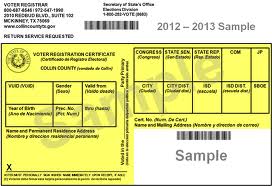However you look at it, we have a lot of registered voters now.
Still the only voter ID anyone should need
With three weeks before the Oct. 11 deadline for the November elections, nearly 80% of the state’s voting age population is registered to vote, putting the number of people eligible to cast ballots to more than 17.5 million and counting, according to the Austin American-Statesman.
Records maintained by the Texas Secretary of State’s Office, show that the new-registration numbers are higher than they were during the midterm cycles of 2014 and 2018, however, the percentage of people of voting age registered has increased only marginally.
This means the addition of new voters is offset by the number of people who have left the registration rolls. Democrats believe the sudden surge of new voter registration is largely due to the Supreme Court’s decision in June to overturn Roe v. Wade’s landmark abortion ruling.
“It’s not just that younger voters are surging in TX since Dobbs,” tweeted Tom Bonier, CEO of the firm, TargetSmart, in reference to the high court’s Dobbs v. Jackson Women’s Health Organization ruling. “It’s clear that those younger voters who are registering now (men and women) are far more Democratic.”
Apart from being motivated by the loss of abortion rights, new voters might have been inspired by the inaction of Texas Republican leaders on gun safety issues in the wake of the May 24 massacre at Robb Elementary School in Uvalde.
On the other hand, Republicans are skeptical about that conclusion. Derek Ryan, a Texas Republican researcher, and consultant, examined data from the three most recent midterm cycles and said the demographic characteristics of new registrants are remarkably consistent, as reported by Austin American-Statesman.
We’ve discussed the voter registration figures and the reasons to maintain some perspective before. I will say that if we get the same turnout percentage in 2022 that we got in 2018, we’ll get about 9.3 million voters in this election, or about 900K more than we got four years ago. That’s also almost exactly double what we got in 2014, when registration was considerably lower and the turnout percentage was almost comically small. The last couple of elections have shown that higher turnout elections are not inherently favorable to one party or the other, but I would still claim that low turnout elections are generally bad for Democrats, at least in Texas.

